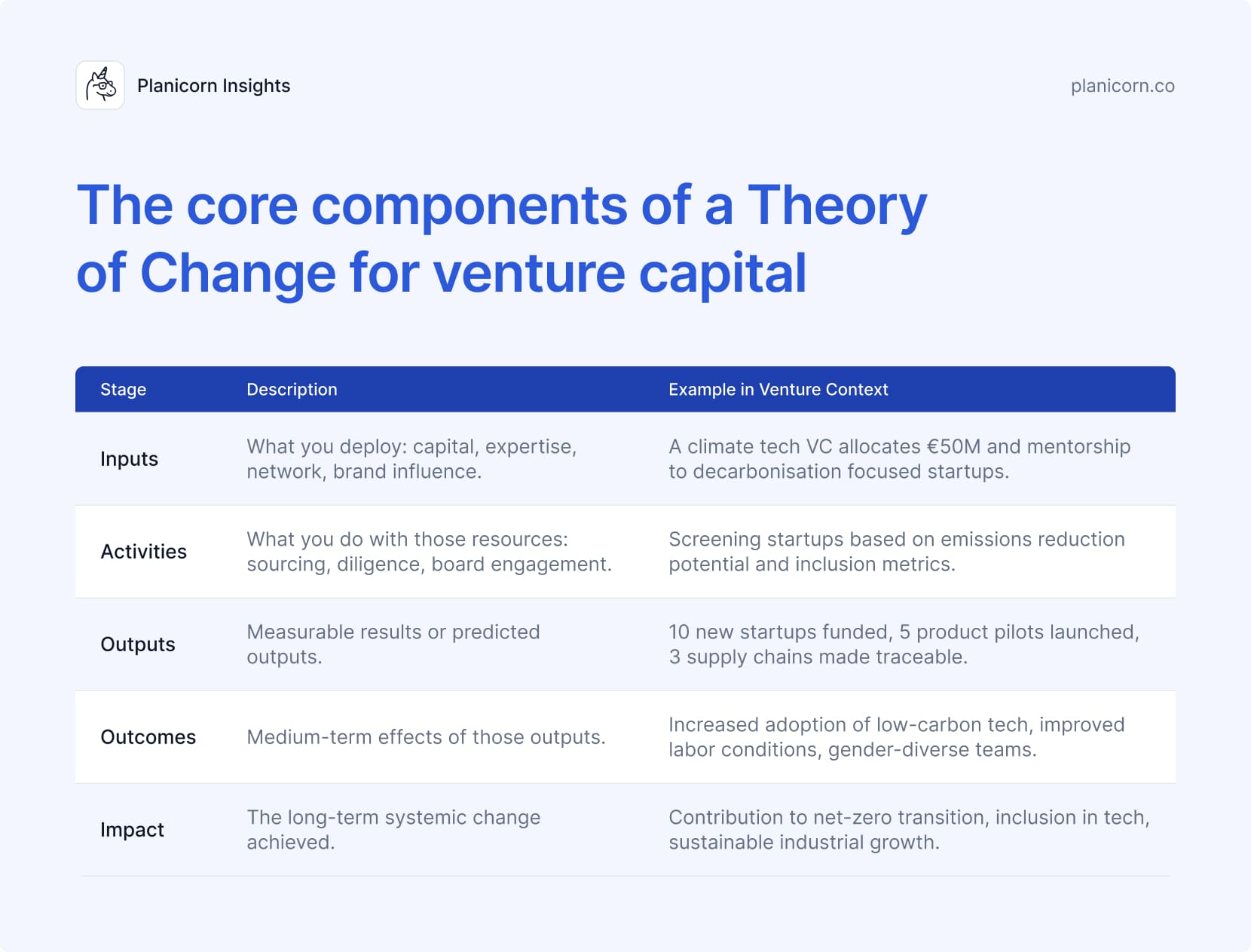Theory of Change definition
A Theory of Change describes the cause-and-effect pathway between what you do and the long-term change you want to see.
It asks and answers a simple question:
If we do X, why do we believe it will lead to Y?
Theory of Change requirements
1. Capital inputs -> The fuel you deploy as a fund or founder.
Think: What resources are we bringing to the table?
- Money
- Expertise
- Network access
- Brand credibility
- Technical support
- Governance resources
2. Investment activities -> What you actually do with those inputs.
Think: What are we doing with the capital to drive change?
- Sourcing and investing in companies
- ESG due diligence
- Board support and founder coaching
- Introducing customers or partners
- Helping set policies or KPIs
3. Portfolio outputs -> The measurable results of those activities.
Think: What happened because we acted?
- Companies funded
- Pilots launched
- Supply chains made traceable
- Carbon footprint measured
- Governance policies implemented
4. Systemic outcomes -> The medium-term shifts caused by those outputs.
Think: What happened because we acted?
- Adoption of low-carbon tech
- More diverse leadership teams
- Reduced emissions in a given industry
- Better labour conditions
- Increased access to essential services
5. Long-term impact -> The long-lasting change you’re contributing to.
- A decarbonised economy
- More inclusive tech ecosystem
- Circular supply chains
- Stronger societal resilience
- Cleaner air, healthier communities
Each step has its own assumptions, which you make explicit, test, and refine over time.
We invest resources (inputs) into specific actions (activities) that produce measurable results (outputs), which create real market or social shifts (outcomes), contributing to long-term positive change (impact).
Why do VCs need a ToC
Venture is built on beliefs about leverage: that a small amount of capital, applied early and strategically, can unlock exponential outcomes later.
That’s already a form of “theory of change.”
But in ESG and impact investing, you need to make that leverage logic transparent, measurable, and credible.
A Theory of Change helps VCs:
- Clarify intent: what kind of impact or change your capital aims to create.
- Connect the dots between your investment thesis, portfolio actions, and real-world outcomes.
- Build trust with LPs who increasingly demand structured, evidence-based impact frameworks.
- Track results over time to prove that value creation and impact creation align.
In short: a Theory of Change is to ESG what a financial model is to valuation, the structure behind the story.
Here’s how a typical VC Theory of Change unfolds, not as a checklist, but as a logic chain.

Each layer depends on explicit assumptions, “If we fund this kind of company, we believe it will lead to…” that you can test and refine over time.
Theory of Change in practice
For funds, the ToC becomes a navigation system for investment and reporting.
Here’s what that looks like:
- During Fund Design: It guides your thesis, what sectors, technologies, or challenges you focus on and why.
- During Due Diligence: It shapes the ESG and impact criteria you apply to deals.
- During Portfolio Management: It identifies what metrics to collect and what improvement looks like.
- During LP Reporting: It becomes your proof of value creation showing causality, not just correlation.
This structured approach also helps funds build SFDR Article 8 or 9 alignment, where demonstrating “sustainability outcomes” is now a regulatory requirement.
Theory of Change for startups
For early-stage companies, a Theory of Change can be just as powerful.
It helps founders show investors that ESG and growth are not competing priorities, they’re linked.
A startup’s Theory of Change can show, for example:
- How its technology reduces emissions, waste, or inequality.
- How scaling its model creates both economic and environmental returns.
- How it measures not just outputs (sales, units shipped), but outcomes (impact per customer, system-level benefits).
The best founders don’t just show traction, they show transformation.
Mistakes to avoid
- Confusing activity with impact: Funding ten startups isn’t an outcome; reducing industry emissions is.
- Overcomplicating it: A good ToC fits on one page. Clarity beats complexity.
- Ignoring feedback loops: The ToC isn’t static, review it annually as markets, data, and regulations evolve.
- Treating it as compliance: LPs can spot boilerplate frameworks. Your ToC should sound like you, not a UN copy-paste.
Connecting to your Responsible Investment Policy
A Responsible Investment Policy explains what you commit to do as a fund.
A Theory of Change explains why those actions matter and how they create real outcomes.
Together, they form the backbone of ESG credibility.
Here’s how they fit:
- The Responsible Investment Policy sets your principles, processes, and expectations:
- how you screen deals
- what ESG risks you consider
- what governance standards you require
- how you report to LPs
- The Theory of Change provides the logic and evidence behind those decisions:
- how your capital (inputs)
- combined with your investment actions (activities)
- lead to measurable ESG results (outputs)
- which drive real-world improvements (outcomes)
- and meaningful long-term impact (impact)
One gives structure. The other gives direction.
Together, they let LPs understand not just what you do, but why it works.
This is exactly why institutional investors are now asking for both.
A Responsible Investment Policy without a Theory of Change is just policy.
A Theory of Change without a Responsible Investment Policy is just theory.
Only when you pair them does it become a credible investment strategy, one that LPs can underwrite, founders can understand, and regulators can evaluate.
And this connection is what most funds still miss.
How can Planicorn help you!
At Planicorn, we help funds and startups design their Theory of Change, linking investment activities to measurable outcomes and LP reporting standards. Because investors don’t just fund companies that grow fast, they fund those that change the system.




